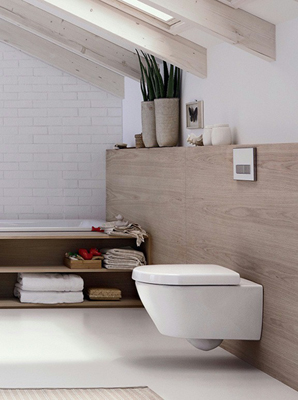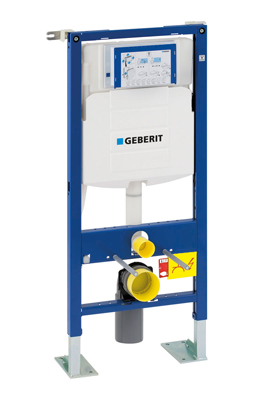
If you're short on space or perhaps looking to give your bathroom a sleek, minimalist kind of feel, then a concealed toilet cistern is a choice worth considering. Concealed cisterns are becoming more and more popular - which in turn means that prices are coming down, and that there are more options than you might suspect.
What is a concealed cistern?
The cistern is the boxy part of the toilet that holds the water before it's flushed. As the name suggests, a concealed cistern is a type of cistern that is mounted inside the wall (in-wall), behind a wall (in-duct), in a ceiling, or within a cabinet or vanity unit.
Concealed cisterns often have a very thin profile to help them fit into a narrow space in the wall cavity. Improvements in the dynamics of how toilets flush in recent years mean that these types of cisterns work just as efficiently as a regular cistern might.
Generally, all that should be visible of concealed cisterns are the flush buttons, also known as push plates. These push plates can either be attached to the cistern, or be installed some distance away from the cistern - and come in a variety of styles and colours to complement almost any bathroom design. Because they're able to be mounted wherever's convenient, cisterns that use a remote flush button are ideal for people with special needs or for those with limited mobility.
If space is your main concern and mounting inside a wall isn't something you're keen on, it's also possible to buy extremely slim cisterns, which save space by sitting almost flush with the wall instead.

What are the benefits of a concealed cistern?
Style is a big consideration for concealed cisterns. Because they can be concealed from view, this adds nicely to a more sleek, modern feel. The push plates are usually the only visible part of the cisterns, and can be chosen to fit in with the rest of your bathroom decor.
In-wall, in-duct or in-cabinet cisterns are often used with wall-faced pans to achieve a certain look - these are toilet bowls which are covered at the back and sit nicely flush with the wall behind them. Concealed cisterns are also a great match for wall hung toilet pans, which are suspended directly from the wall for a very clean, modern look.
Space is an obvious advantage where concealed cisterns are concerned, and it's no surprise that they're commonly used in smaller bathrooms - particularly in apartments and smaller ensuites.
Some manufacturers also claim hygiene benefits to concealed cisterns too, due to the fact that there are fewer nooks and crannies in which bacteria can grow.
Are there any problems associated with concealed cisterns?
There's a general perception that concealed cisterns are always more costly or complicated than normal cisterns, although this often isn't the case. The cost and ease of installation, in many situations, is likely to be comparable with what you'd expect with an exposed, close coupled cistern.
There's also a perception that concealed cisterns will be more difficult to access and service than normal cisterns too (particularly because they're embedded inside the wall) - although this concern's mostly unfounded if you're opting for a reputable brand. In most cases, these cisterns are designed with ease of servicing very much in mind, and a licensed plumber can typically service a concealed cistern within 5-7 minutes.
As with all things, opting for a good quality (Australian Standards compliant) product from a reputable brand is the best way to ensure you don't have problems.
|
Advantages
|
Disadvantages
|